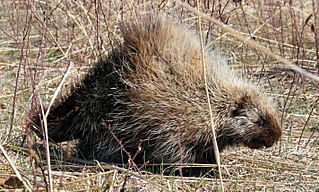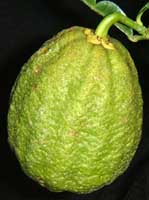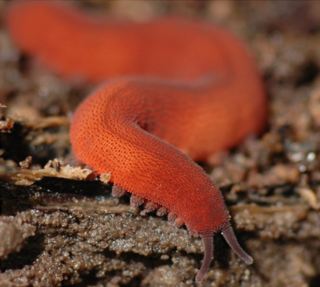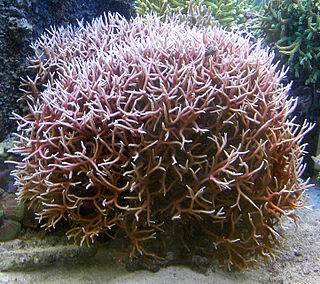
Porcupines are large rodents with coats of sharp spines, or quills, that protect them against predation. The term covers two families of animals: the Old World porcupines of the family Hystricidae, and the New World porcupines of the family Erethizontidae. Both families belong to the infraorder Hystricognathi within the profoundly diverse order Rodentia and display superficially similar coats of rigid or semi-rigid quills, which are modified hairs composed of keratin. Despite this, the two groups are distinct from one another and are not closely related to each other within the Hystricognathi. The largest species of porcupine is the third-largest living rodent in the world, after the capybara and beaver.

Citrus hystrix, called the kaffir lime or makrut lime, is a citrus fruit native to tropical Southeast Asia.

Peripatus is a genus of velvet worms in the Peripatidae family. The name "peripatus" is also used to refer to the Onychophora as a whole, although this group comprises many other genera besides Peripatus. The genus Peripatus is found in Central America, the Caribbean and northern South America. Velvet worms in this genus can have as few as 24 or 25 pairs of legs or as many as 36 leg pairs. This genus is viviparous, with mothers supplying nourishment to their embryos through a placenta.Peripatus is sometimes considered a living fossil because it and other onychophorans are transitional between Arthropoda and Annelida and retain a large number of archaic features

The Indian crested porcupine is a hystricomorph rodent species native to southern Asia and the Middle East. It is listed as Least Concern on the IUCN Red List. It belongs to the Old World porcupine family, Hystricidae.

Catcott, Edington and Chilton Moors SSSI is a 1083 hectare biological Site of Special Scientific Interest in Somerset, England notified in 1967. It is close to the villages of Edington and Catcott.

The Malayan porcupine or Himalayan porcupine is a species of rodent in the family Hystricidae. Three subspecies are extant in South and Southeast Asia.

Papeda or papaeda is the common name for a group of Citrus species and varieties native to tropical Asia that are hardy and slow-growing, and produce unpalatable fruit. Walter Tennyson Swingle segregated these species into a separate subgenus, Papeda, that included the Ichang lemon, yuzu, kaffir lime, kabosu, sudachi, and a number of wild and uncultivated species and hybrids. Recent genetic analysis shows the papedas to be distributed among distinct branches of the Citrus phylogenetic tree, and hence Swingle's proposed subgenus is polyphyletic and not a valid taxonomic grouping, but the term persists as a common name.

Elymus hystrix, known as eastern bottlebrush grass, or bottle-brush-grass, is a bunchgrass in the grass family, Poaceae. It is native to the Eastern United States and Eastern Canada.
Ichthyosis hystrix is a group of rare skin disorders in the ichthyosis family of skin disorders characterized by massive hyperkeratosis with an appearance like spiny scales. This term is also used to refer to a type of epidermal nevi with extensive bilateral distribution.

Epiperipatus is the most diverse genus of neotropical velvet worms in the family Peripatidae. Species in this genus are found in Central and South America. Velvet worms in this genus can have as few as 23 pairs of legs or as many as 39 leg pairs. This genus is viviparous, with mothers supplying nourishment to their embryos through a placenta.

The Metopininae are a subfamily of flies in the family Phoridae.

Seriatopora hystrix is a species of colonial stony coral in the family Pocilloporidae. It forms a branching clump and is commonly known as thin birdsnest coral. It grows in shallow water on fore-reef slopes or in sheltered lagoons, the type locality being the Red Sea. It is native to East Africa, the Red Sea and the western Indo-Pacific region. It is a common species and the International Union for Conservation of Nature has assessed its conservation status as being of "least concern".
Oroperipatus peruvianus is a species of velvet worm in the Peripatidae family. Males of this species have 34 pairs of legs; females have 36 or 37. Female specimens range from 55 mm to 61 mm in length. The type locality is in Peru.
Peripatus basilensis is a species of velvet worm in the Peripatidae family. This species has 26 to 31 pairs of legs. The type locality is in Haiti.
Peripatus darlingtoni is a species of velvet worm in the Peripatidae family. The female of this species has 33 or 34 pairs of legs. The type locality is in Haiti.
Peripatus haitiensis is a species of velvet worm in the Peripatidae family. The female of this species has 30 to 32 pairs of legs. The type locality is in Haiti.
Peripatus lachauxensis is a species of velvet worm in the Peripatidae family. The female of this species has 30 to 33 pairs of legs. The type locality is in Haiti.

Phalacrotophora is a genus of scuttle flies. There are at least 50 described species in Phalacrotophora.

The Metopininae is a tribe of flies in the family Phoridae.
Xanionotum is a genus of flies in the family Phoridae.











